Deconstruyendo Fortnite: una mirada más profunda al pase de batalla
Publicado cruzado desde Deconstructor of Fun . Coescrito con Joseph Kim .
Ya es difícil pasar un día sin oír hablar de Fortnite. En febrero, Fortnite superó a PUBG en ingresos totales en PC y consola (126 millones de dólares frente a 103 millones de dólares). Mientras PUBG (Player Unknown's Battlegrounds) inició un movimiento, Fortnite creó un fenómeno.
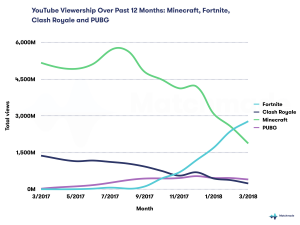
Fortnite es, con diferencia, el juego más visto y transmitido en YouTube. fuente: Matchmade.tv
Sin embargo, mientras el género Battle Royale continúa calentándose, me gustaría centrarme en un tema específico: el sistema Battle Pass como motor de monetización . Fortnite, a pesar de todas sus decisiones inteligentes y defectos, tomó una decisión clave meses después de su lanzamiento: no iba a monetizar basándose en cajas de botín, sino que iba a monetizar a través de su sistema Battle Pass.
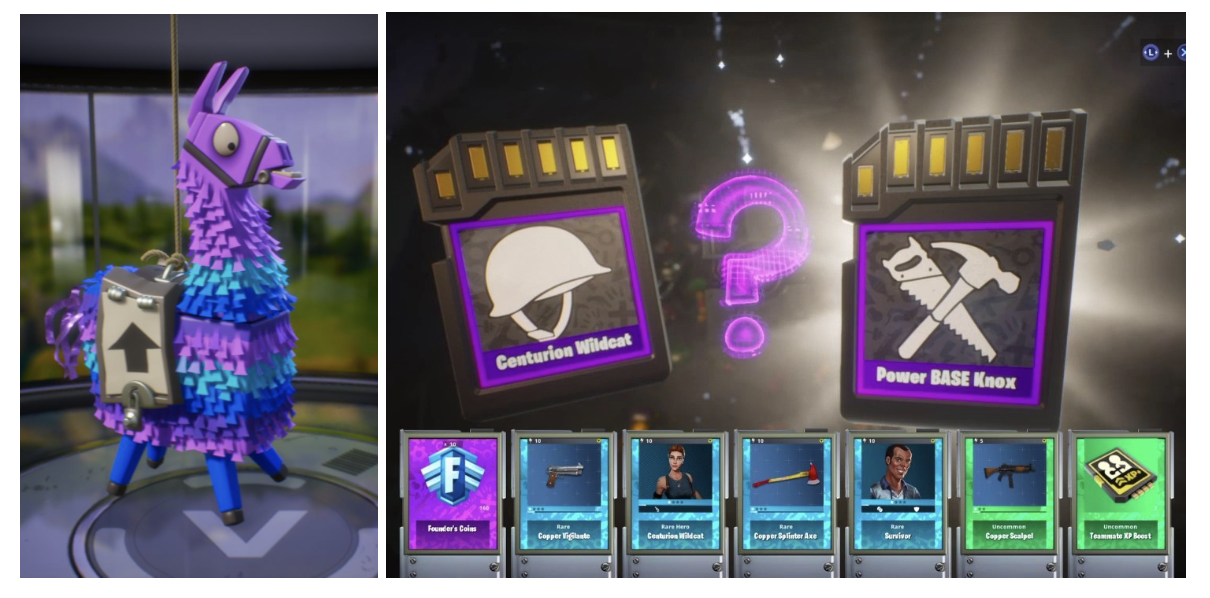
No es como si Epic no hubiera pensado en convertirlo en una economía impulsada por cajas de botín: el modo "Salvar el mundo" de Fortnite es una economía impulsada por cajas de botín en la que compras piñatas con temas de llamas que contienen elementos aleatorios que impactan el juego. Sin embargo, para su sistema Battle Royale, optaron por ir en contra de esto.
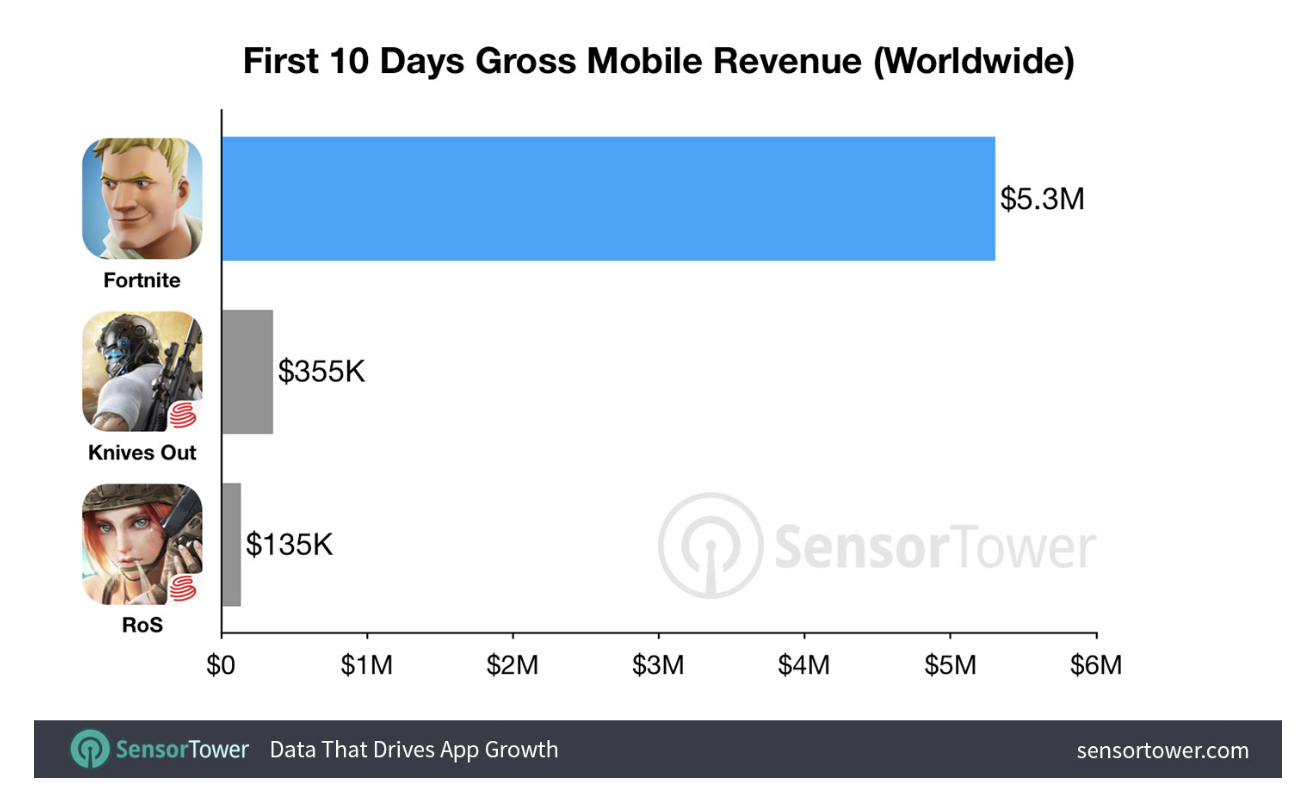
Independientemente de lo que pienses de la elección, los ingresos de Fortnite muestran que han hecho algo bien. Fortnite se ha mantenido estable como el juego con mayor recaudación en dispositivos móviles durante semanas, demoliendo los títulos tradicionales gratuitos para dispositivos móviles y superando a todos los demás juegos de estilo Battle Royale en dispositivos móviles tanto en descargas como en ingresos. El hecho de que el juego fuera solo por invitación durante las primeras semanas hace que la hazaña sea aún más impresionante.
Sin embargo, estos resultados plantean una pregunta: ¿los ingresos provienen simplemente del tamaño de la base de usuarios (DAU), o el sistema Battle Pass en realidad genera mayores ingresos por usuario que un sistema de caja de botín? En términos de KPI, compararíamos ARPDAU o, idealmente, LTV.
Si bien nadie más que Epic puede echar un vistazo detrás de la cortina y ver cuáles son sus métricas, ¡hoy especularemos!
La economía impulsada por los cosméticos de Fortnite
Al igual que en los MOBA, la progresión y la monetización de Fortnite solo provienen de los cosméticos. Fornite es un modelo de “ganar gratis”: no venden nada que pueda afectar el equilibrio del juego Battle Royale. Todas las armas, armaduras y municiones se recogen en el juego Battle Royale, pero un jugador puede elegir qué cosméticos quiere llevar a una partida.

Fortnite te permite seleccionar una serie de opciones cosméticas para llevar a la batalla:
- Un aspecto/atuendo que usa tu personaje
- “Back Bling” – o una mochila
- Herramienta de recolección : un pico es aburrido, ¿por qué no una guadaña?
- Contrail— what Glider you use while falling (gotta look cool while falling)
- Loading Screen — what loading screen you see (only for yourself)
- Emotes to communicate with others. (you can bring in 6 emotes which you can trigger)
Since progress isn’t made through traditional stats and level up, the only way to show off your progress is through cosmetics. It’s not pay-to-progress, it’s pay-to-look-cool.
Until Fortnite, cosmetics-only based mobile games have not been able to achieve strong overall revenue, at least in Western markets. Although the large revenue growth certainly derives strongly from a massive number of installs, the amount of revenue and the #1 top grossing status cannot be explained without a level of monetization heretofore unseen by cosmetics in Western markets on mobile.
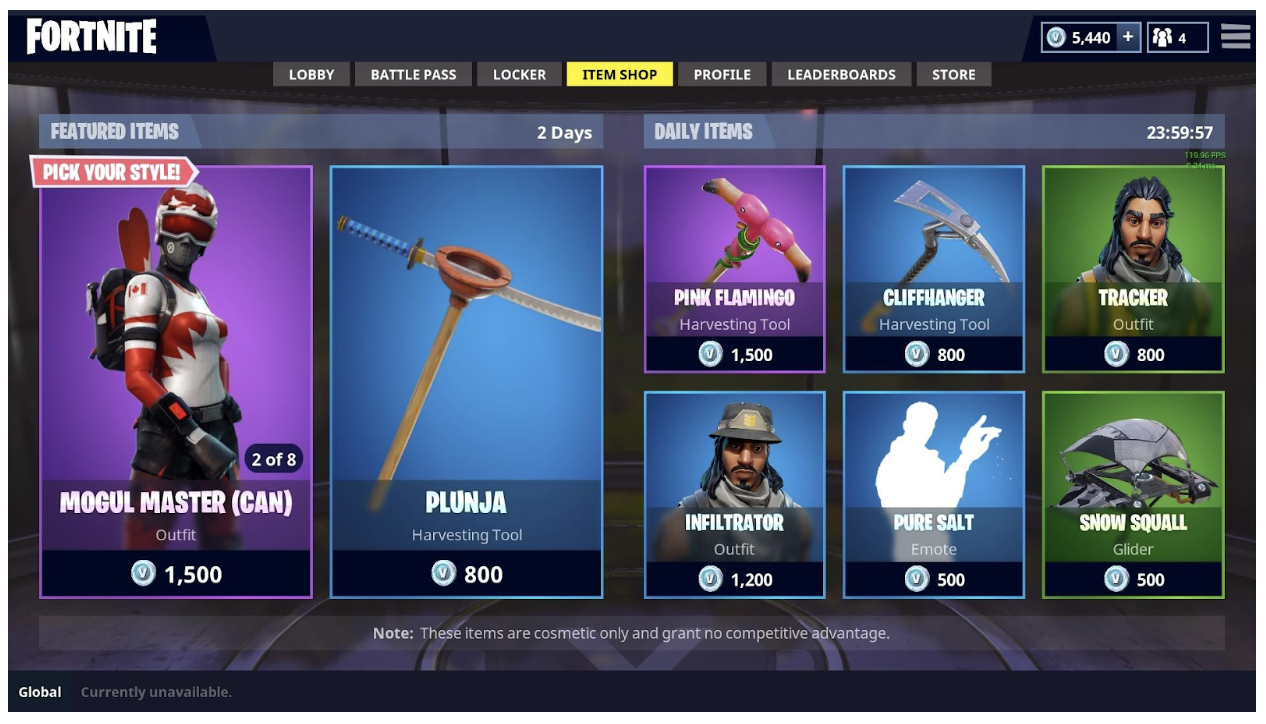
With the cosmetic driven economy, rather than dropping new cosmetic gear through gacha/loot boxes (like Overwatch, Destiny, etc.) cosmetics are either purchased with V-bucks (premium currency) or earned through the battle Pass. Interestingly, directly purchasing cosmetics through the shop has limited access. Each day there is a limited selection of items to purchase, so while loot boxes aren’t included in the economy, there is a limited set of items that are available at any time. Great for driving players to check the shop out daily, and giving additional pressure to purchase items while they are available.
The Battle Pass
Besides being able to purchase cosmetics with premium currency, players can also play and earn cosmetics and consumable boosts by completing their Battle Pass.
The Battle Pass is a set of rewards which can be unlocked by completing challenges. Completing challenges rewards the player with XP, which increases your tier, which unlocks subsequent rewards. The challenges themselves range in difficulty but give a baseline of progress for the Battle Royale style game.
When playing a Battle Royale game, especially if you’re not skilled, most games will end up with getting shot and losing all your progress. Also in many battle royale games there can be times when you’re waiting around for other players to arrive. These challenges give players additional goals to think about while playing, and can make even a losing round feel like progress.
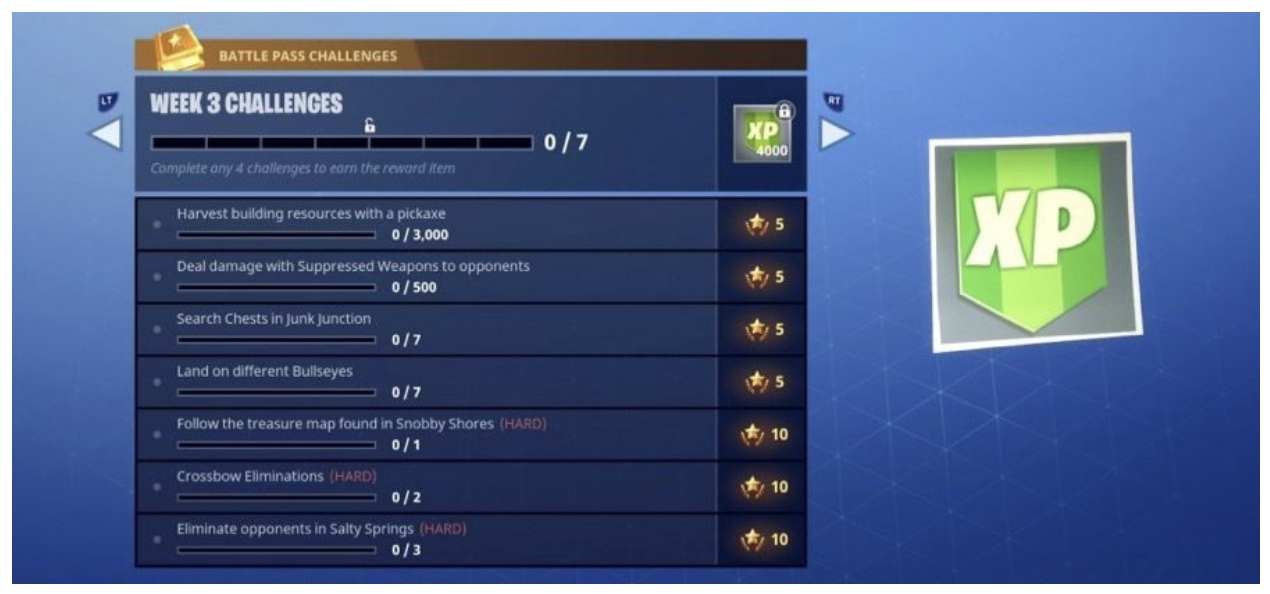
The monetization comes in with the free vs premium tracks, much like the VIP system in Wargaming’s World of Tanks (read the full deconstruction of World of Tanks). Free players get far fewer rewards than the premium tier. Creating a very clear conversion effort. Look at all the stuff you “earned” but didn’t receive! The amount of content given out for the premium tier is compelling — its generous in terms of the payoff and pays back your effort quickly. This feels very similar to Annuities or “Subscription Diamonds” in mobile games. A small price that pays out far more than it costs – but only if you engage in the game.
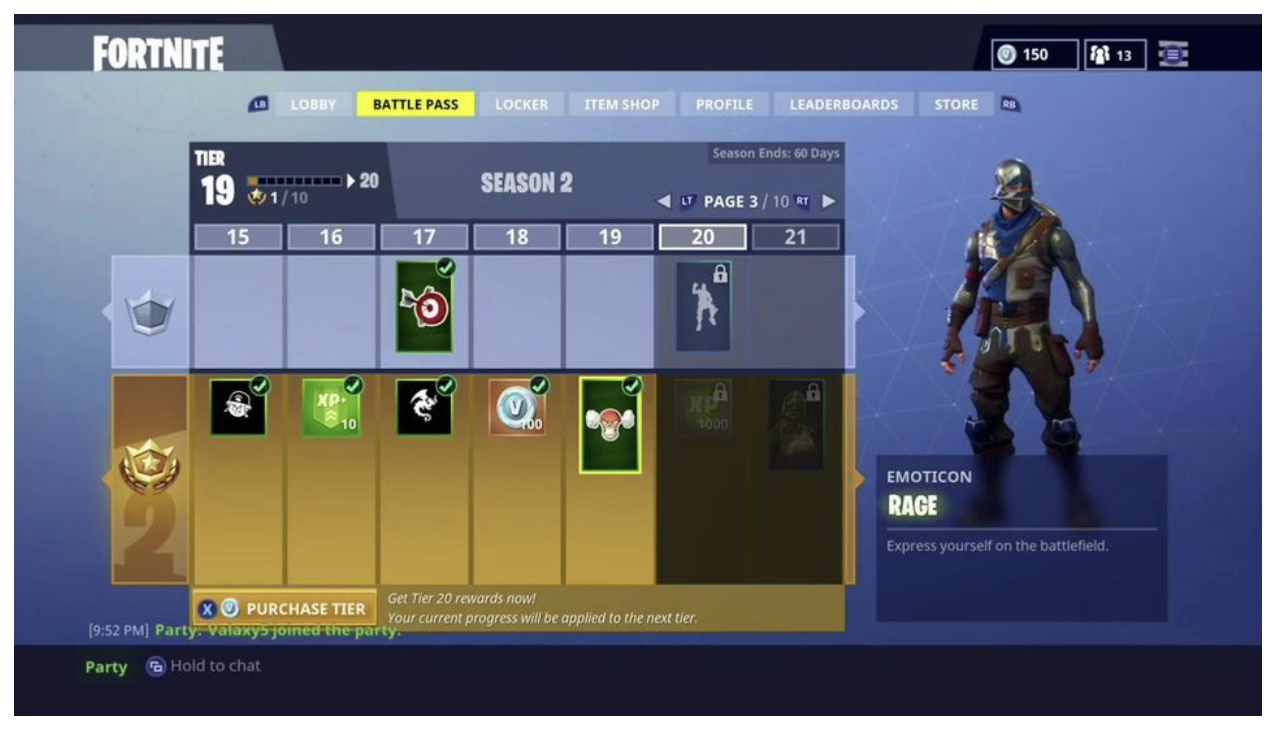
The Battle Pass is limited to a season, which is what makes it so compelling. Each season has a matching Battle Pass, which comes with its own set of cosmetic content and rewards. If you don’t complete the battle pass in time — you don’t get the content. Some content may come in and out of the store on a daily basis — but then it’s usually for high costs of premium currency.
There’s a big “Fear of Missing Out” feeling with this system.
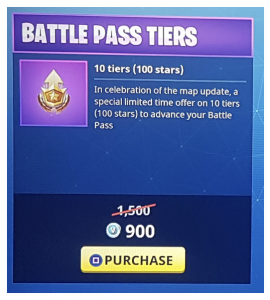
If being able to directly purchase progress was in any other game, most free-to-play designers would shoot this down. It’s usually a far better idea to monetize players on the gameplay itself and not allow players to directly pay to skip. It would feel very pay-to-win if you could directly pay to reach the top arena in Clash Royale, or pay to skip a set of levels in Candy Crush.
However, since Fortnite can’t really monetize on the core gameplay, and this is really just paying to reach cosmetic content (your battle pass tier isn’t really a metric player compare as a sign of skill) — player’s don’t seem to mind, and their revenue isn’t impacted. Player’s have a way to pay-for-progress to the cosmetic items they want.
Want a head start on the season so you can show off the cosmetic items before your friends get there? Pay to skip ahead!
A week’s challenges or season coming to a close and you don’t have time to get all the remaining challenges? Pay to skip ahead!
For this reason, the spend depth and potential of the battle pass system shouldn’t be seen as limited to just the monthly purchase price. When a player has locked into the battle pass, they are more likely to be highly engaged that season to unlock the content and to convert on skipping ahead to get all that content they unlocked.
User Experience of Battle Pass vs. Loot Boxes
Battle Pass can be best described as a system first and foremost for retention and player experience. Comparing Battle Pass to Player Unknown Battlegrounds (PUBG), it gives players real goals, a direct sense of progress, and a clear path to the cosmetics that they want. PUBG instead uses a loot box system to gate all of their cosmetic content. Players play a match, get as many “Battle Points” (BP) as possible, to eventually open up a loot box.
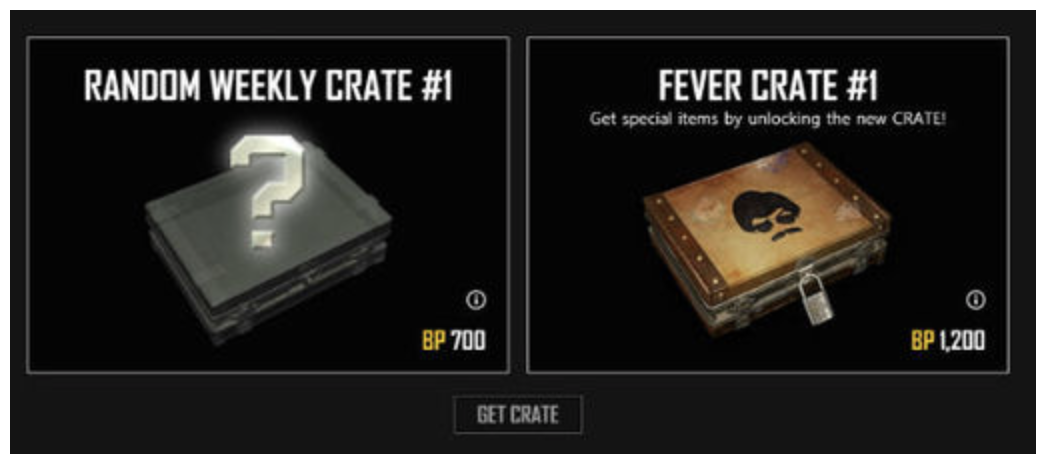
These loot boxes can sometimes be locked with a key that needs to be bought with real money, which feels pretty much like a blatant rip-off. Like most gacha systems, as a player, this means the path to desired content is completely luck-driven. You can’t even save your BPs or a dust-like currency (example: Credits in Overwatch, or Dust in Hearthstone) to eventually get the item that you want. You just need to get lucky.
From a player’s perspective, Battle Pass simply feels fair compared to the competitors gacha systems.
So overall, from a player’s perspective, Fortnite’s Battle Pass system is a great match for battle royale:
- It gives secondary goals which give a strong baseline of progress and can keep the game interesting
- It gives players a clear marker of progress through a season and a goal of what to accomplish besides just killing every round
- It’s a compelling conversion item + retention driver. The amount of content for the price and the clear visual of seeing content that you “earned” but can’t access is a compelling driver to both monetize and engage in the game.
- It creates an endowment effect of purchasing an item but only being able to unlock the content if you engage highly in the game
But it’s not as if this Battle Pass system came from nowhere, it’s obviously inspired by the playbook of Valve’s DOTA2. Their compendium battle pass has been a staple of that game since 2013. Looking at Valve’s evolution of the compendium, you can see potentially how this system will evolve in Fortnite.
The Benchmark: DOTA2’s Battle Pass
Started in 2013 as an incentive for players to donate get interested in the e-sports scene of DOTA2, the compendium was essentially an interactive guide to an upcoming tournament. Similar to a guidebook you’d get at a sporting event: it told you about the players, tracked the stats, and got you interested in the game itself. Valve doubled down on this by making it digital, interactive, and gave a portion of the money raised by the compendium as part of the prize pool. Players had a way of supporting the esports scene for their favorite game.
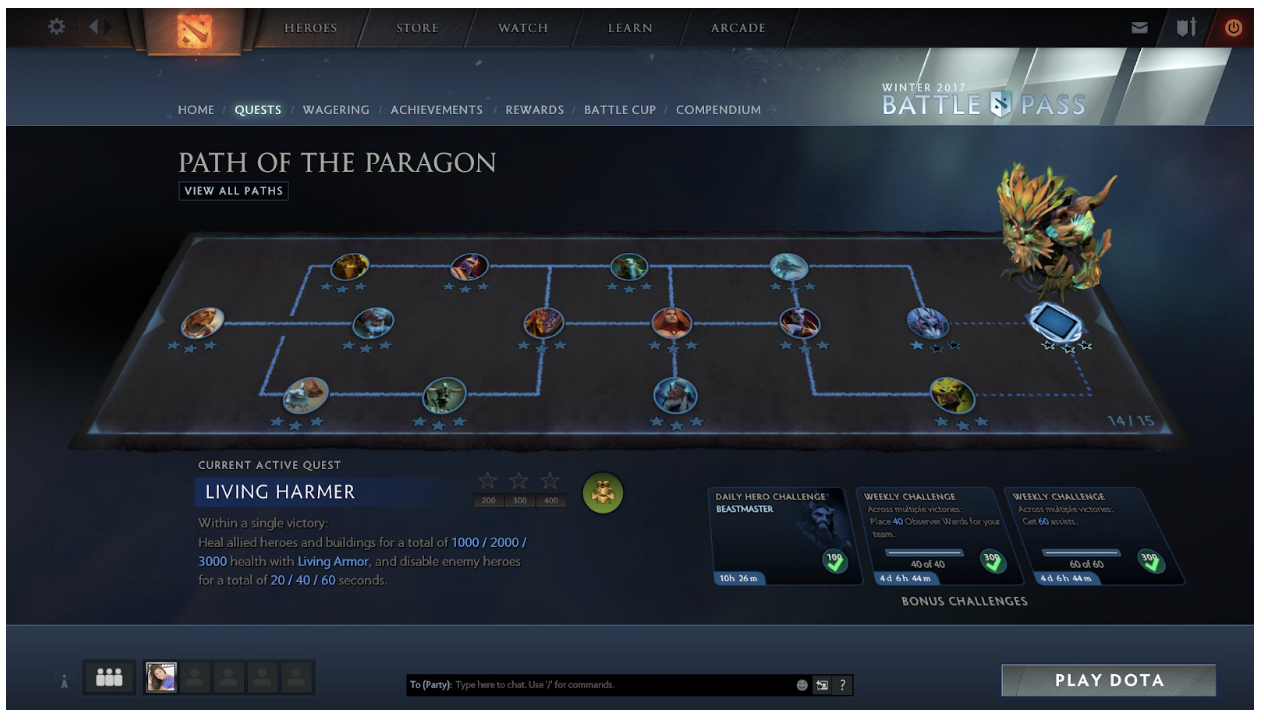
This has since evolved quite a bit. What started as just a compendium turned into a battle pass. They eventually added goals for players to accomplish in PvP that would increase their level for that season, and unlock cosmetic rewards (just like Fortnite’s today). However, DOTA2 has gone far deeper, with a number of recent additions that significantly increase the depth of the system.
- Multiple Paths give players choices as they progress in the battle pass, giving far more goals in parallel for advanced players. Also, give further reason to reach higher levels in the battle pass (some paths only unlock when you’ve reached a high enough level).
- Unlimited tiers with content unlocking slower and slower over time. Whereas Fortnite is capped at 100 tiers of content, DOTA2 has unlimited. This creates situations where players are even competing against each other to see who can progress farther in a season (when the competition itself is directly pay-to-progress)
- Treasures/Loot Boxes as rewards rather than direct cosmetics. This gives players a mix of direct rewards and a chase to get the random rewards that they want.
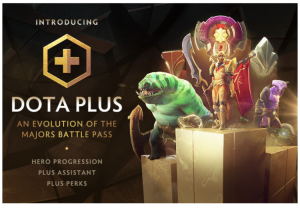 So while Fortnite’s Battle Pass system may just be in its “early access” phase right now with a basic feature set, it’s clear that Epic is taking inspiration from Valve’s similar Battle Pass system. This evolution shows that the current implementation is not just limited to 100 tiers of content, but could be a far longer lasting and complex chase which could drive even higher retention and monetization. This system clearly has been successful for DOTA2, since recently they’ve started to shift the system to a full-on subscription style service called “DOTA Plus”. Little details are known at this point, but it looks to be replacing the Battle Pass with an ongoing subscription that gives even further systems and progression.
So while Fortnite’s Battle Pass system may just be in its “early access” phase right now with a basic feature set, it’s clear that Epic is taking inspiration from Valve’s similar Battle Pass system. This evolution shows that the current implementation is not just limited to 100 tiers of content, but could be a far longer lasting and complex chase which could drive even higher retention and monetization. This system clearly has been successful for DOTA2, since recently they’ve started to shift the system to a full-on subscription style service called “DOTA Plus”. Little details are known at this point, but it looks to be replacing the Battle Pass with an ongoing subscription that gives even further systems and progression.
But comparing the Battle Pass system to a pure-gacha system, is Fortnite (and potentially DOTA2) leaving money on the table? While it’s obvious that its a play for stronger retention and higher conversion, is the lower spend depth hurting them?
Is the tradeoff of giving away all this cosmetic content for higher conversion really the smartest business decision?
Revenue Analysis of Battle Pass
Just how impactful is Battle Pass to monetization? More specifically, we should ask this question on two levels of scope:
- Battle Pass vs. Cosmetics: How does Battle Pass monetization compare to other forms of cosmetics based F2P, mobile monetization?
- Battle Pass Overall: How does Battle Pass monetization compare to F2P, mobile monetization overall (including pay-to-progress models)?
We can get a rough sense for both of these questions by doing some high-level comparison. In particular, we can a) compare monetization of the various “fair-to-play”, cosmetics driven Battle Royale games and then b) compare monetization with “pay-to-progress” game monetization schemed games.
As an initial investigation let’s take a look at lifetime average revenue per install (ARPI) of each of these titles based on Sensor Tower data to comparative, key high-performing titles:
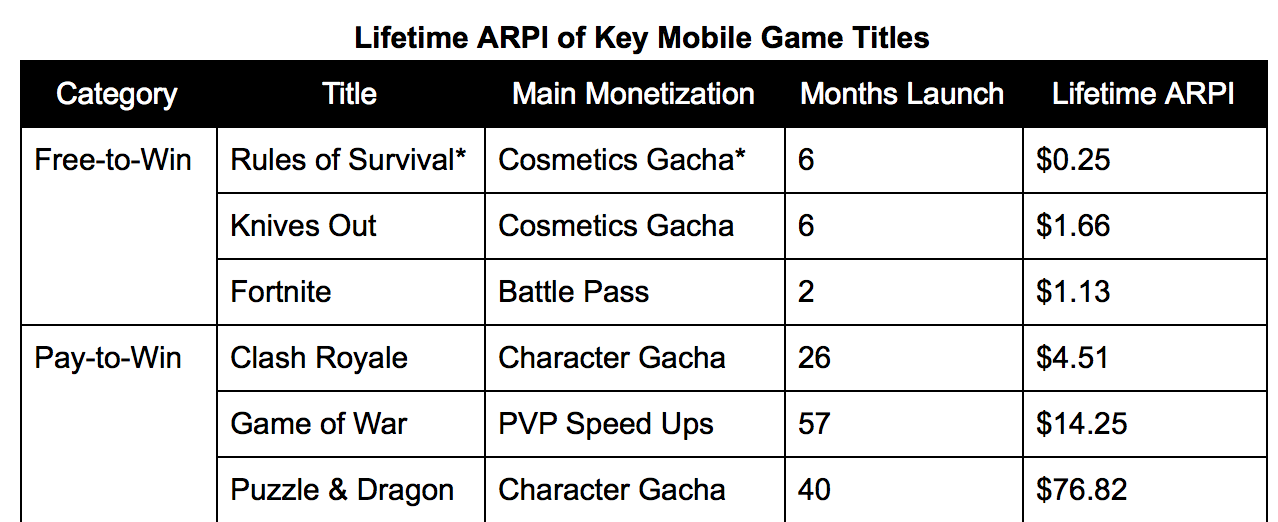
*Note: Rules of Survival does contain some weapons in its loot box, while they are balanced it is not strictly a cosmetics gacha
Source: ARPI based on Sensor Tower data
Battle Pass vs. Cosmetics
Let’s now address the first monetization question we posed above: How does Battle Pass monetization compare to other forms of cosmetics based F2P, mobile monetization?
At first glance, it would seem that Knives Out has the best per user monetization (ARPI) of the Fair to Play games. However, two issues are not fully captured by the chart above:
- ARPI growth over time and
- Audience distribution.
#1. ARPI Growth Over Time
Note the number of months in launch in the Lifetime ARPI chart above. Generally speaking, the longer a game sits in launch, the better the game’s ARPI becomes (eventually achieving it’s LTV):
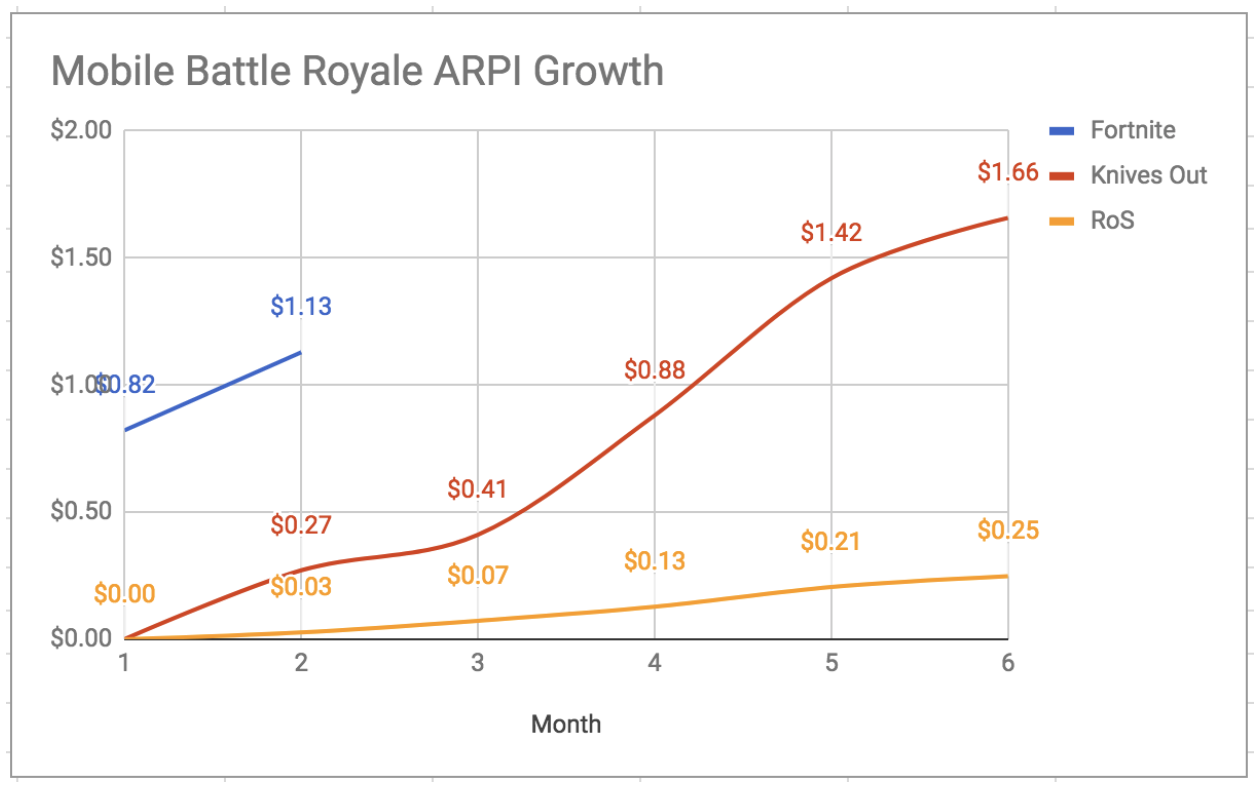 Source: Based on SensorTower Data
Source: Based on SensorTower Data
Note the number of months since launch in the lifetime ARPI (avg. revenue per install) chart above. Generally speaking, the longer a game thrives in live operations, the better the game’s ARPI becomes (as the installs decrease and existing users spend more during their lifetime):
#2. Audience Distribution
The other key driver for monetization for Knives Out is it’s audience. Japan *generally* monetizes much more strongly than other countries, often 2x+ that of US. Hence, the large concentration of Japanese users in Knives Out primarily drives the monetization gap between Knives Out and Rules of Survival.
You can see the revenue split by top 5 countries for all three of the games below:
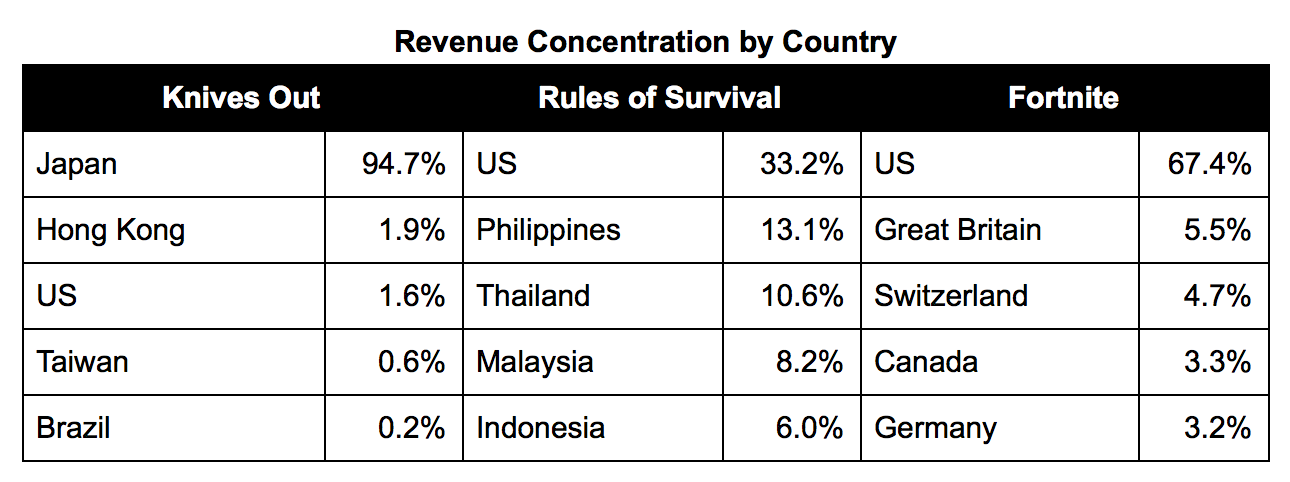
Source: SensorTower
So what happens to monetization if we were to exclude Japan?

Wow, what a difference a country makes! Without Japan, Knives Out actually becomes the worst performing game in term of monetization. Somehow Fortnite per user monetization actually does better without Japan.
Battle Pass vs. Mobile Free-to-Play
Let’s now address the second question we posed regarding Battle Pass monetization earlier: How does Battle Pass monetization compare to F2P, mobile monetization overall (including pay-to-progress models)?
From the Lifetime ARPI chart, it would seem to indicate that more traditional F2P monetization mechanics such as gacha or PVP speed-ups are much more effective on a per-user, unitary level than cosmetics based monetization.
However, we should also take two factors into consideration:
- Months to LTV: How much further can a cosmetics driven monetization last over time?
- Downloads vs. ARPI: Although ARPI for “free-to-win” games may not be as high as other, more traditional F2P monetization mechanics, these games should generate higher install volumes based on the friendlier monetization scheme.
Let’s discuss both of these points in turn.
#1. Months to LTV
So how long can gacha based games continue to increase ARPI until it hits LTV? Unfortunately, we only have 6 months of data on Rules of Survival and Knives Out and less than 2 full months for Fortnite.
One way to estimate the ARPI growth is to just do a logarithmic trendline and extend out the timeframe to say 20 months.
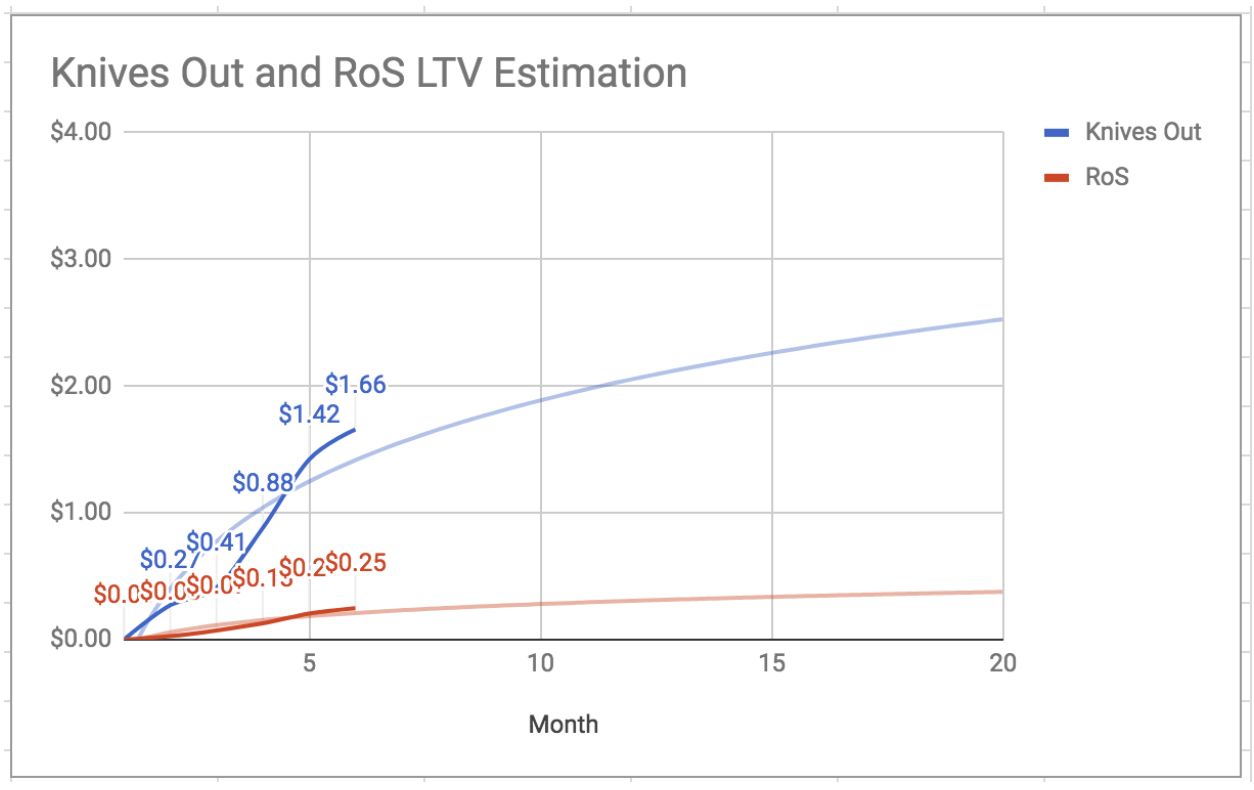
Another way we could guess the eventual LTV of these games is by taking a look at other game examples such as Clash Royale:
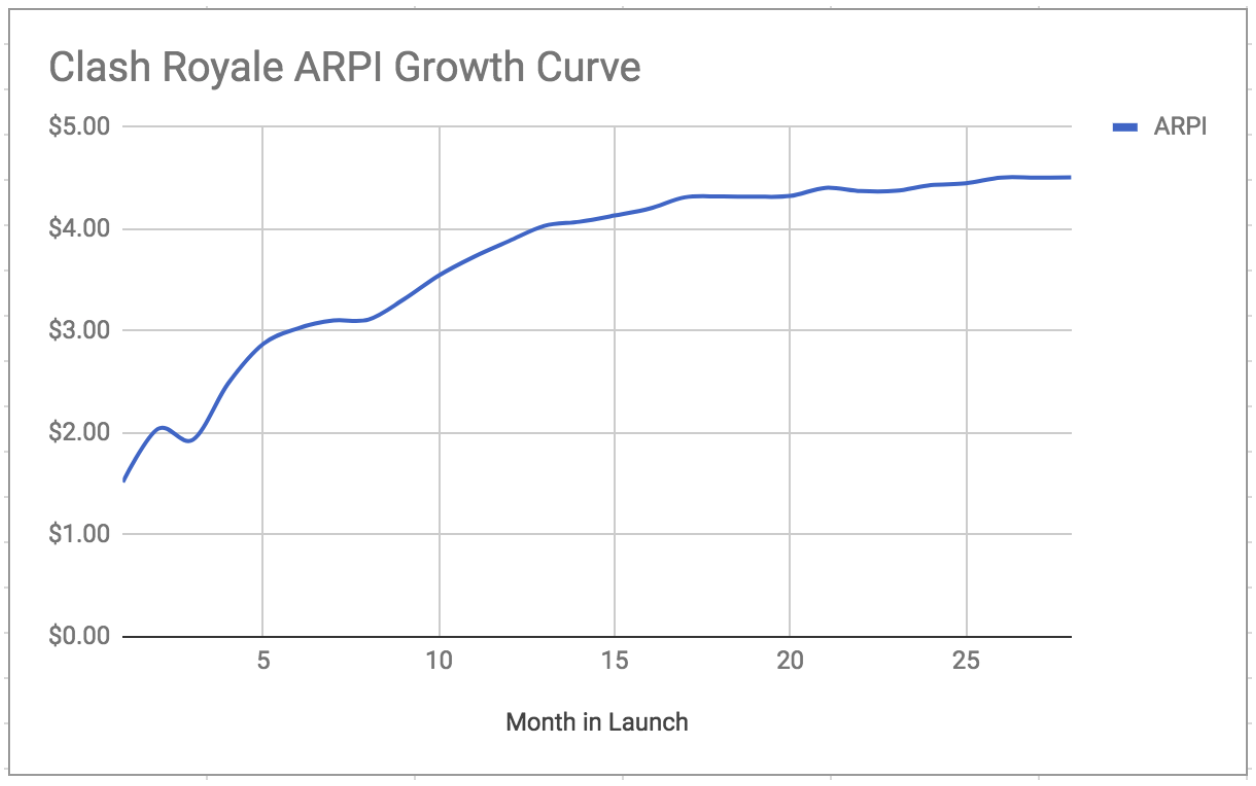
Source: Based on SensorTower data
Based on the above ARPI growth continued for at least 15-20 months. Hence, the 20 month timeframe for our logarithmic trendline earlier.
Traditional F2P designers would typically assume that cosmetics driven monetization should hit their LTV ceiling much sooner than a well-designed gacha game.
However, for the sake of simplicity, and just to get a rough feel let’s assume that the fair-to-play game monetization will follow a similar trajectory. In fact, let’s just eyeball all of this pretty roughly to estimate LTV.
Assumptions based on a rough eyeballing of Clash Royale ARPI growth:
- RoS/Knives Out aumentará otro 50%
- Fortnite aumentará un 125%

A primera vista, Knives Out y Fortnite tendrían estimaciones de LTV a largo plazo similares según nuestro análisis anterior. Sin embargo, cuando tomamos en cuenta la concentración de la audiencia, podemos concluir que Fortnite tiene un diseño de monetización mucho más sólido. Esto quedó claramente demostrado cuando anteriormente excluimos a Japón de nuestros datos de monetización.
#2. DL frente a ARPI
Aunque hasta ahora nos hemos centrado principalmente en medidas económicas unitarias como ARPI, al final del día, lo que más importa será la cantidad de ingresos (y ganancias) generales que un juego puede generar. Por lo tanto, además de ARPI/LTV, también debemos considerar la economía a nivel de producto, considerando también las descargas y, a su vez, los ingresos generales.
Como puede ver en el cuadro a continuación, si bien la monetización basada en juegos gratuitos no ha funcionado tan bien por jugador, los ingresos generales pueden ser bastante saludables incluso en comparación con los principales tipos de juegos de pago por progreso.
También tenga en cuenta que solo tenemos menos de 2 meses de datos para Fortnite (por lo que no es una comparación de manzanas con manzanas) y se ha visto limitado por una serie de problemas , como ser solo iOS y tener requisitos de dispositivos de alta gama.
Además, Clash Royale, a diferencia de otros títulos, aprovechó una de las IP más sólidas en juegos móviles y utilizó la adquisición masiva de usuarios para ayudar a generar un mayor volumen de instalación para su juego.
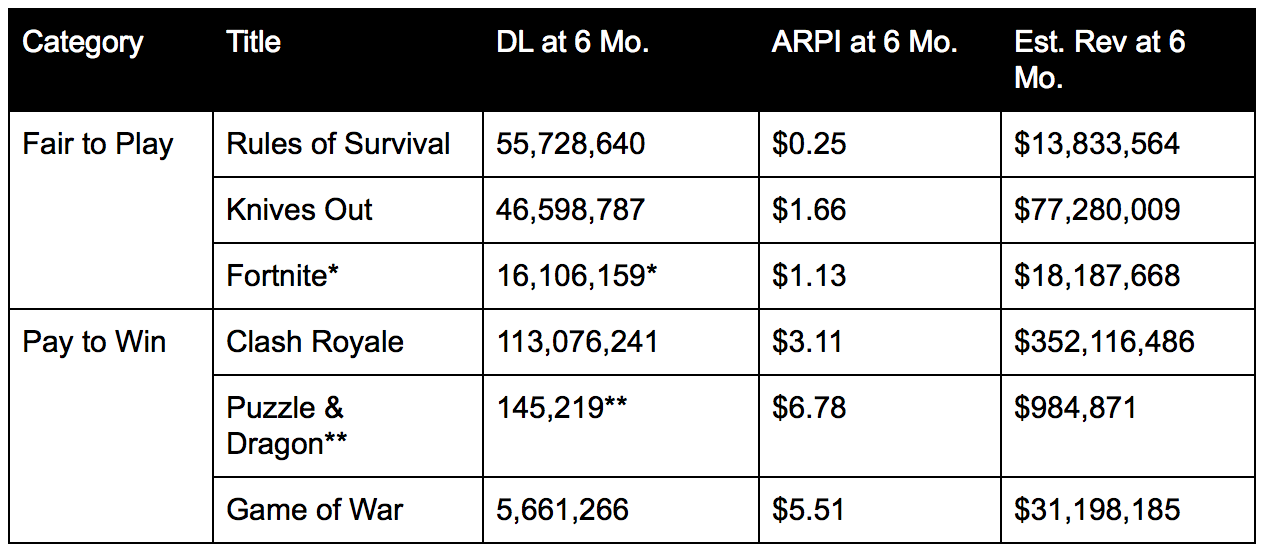
* Menos de 2 meses de datos únicamente y actualmente solo en iOS
** Puzzle Dragon comenzó solo en Japón
Fuente: SensorTower
¡Pase de batalla para ganar!
Entonces, ¿cuál es nuestra conclusión sobre las preguntas originales sobre monetización que planteamos con respecto al Pase de batalla?
Si bien las economías de estilo pago para progresar ciertamente generarán mayores ingresos por jugador, para los juegos que monetizan los cosméticos el pase de batalla ciertamente está mostrando resultados impresionantes . Es probable que Battle Pass se convierta en un sistema de monetización dominante utilizado con la monetización basada en cosméticos en el futuro. No solo puede proporcionar una experiencia de jugador mucho mejor, sino que, mediante un cálculo aproximado, muestra que puede generar un LTV más alto.
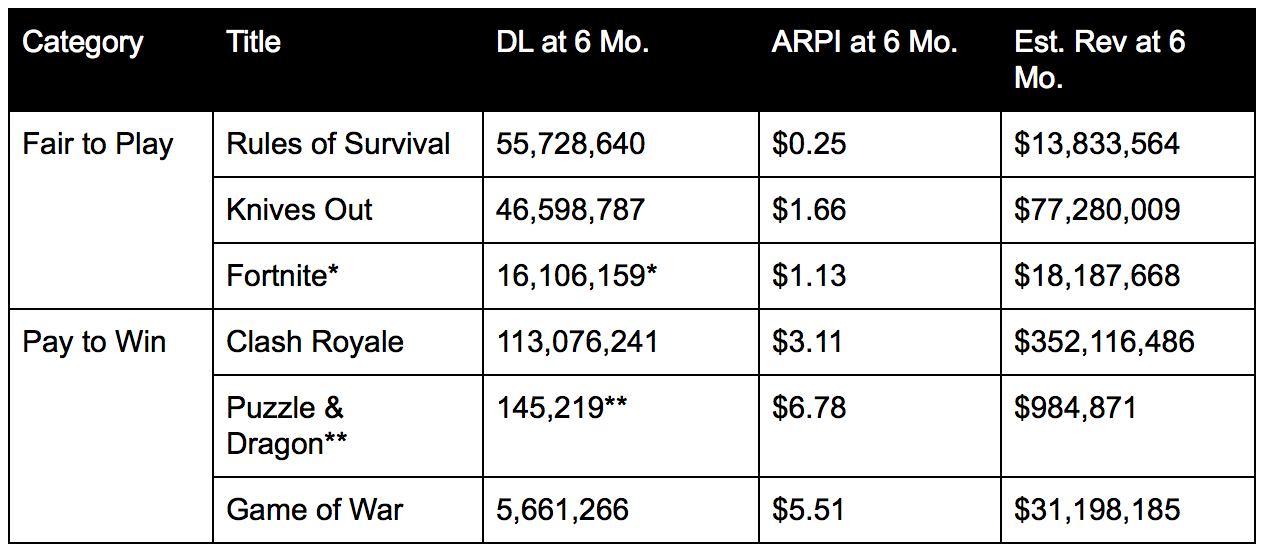
Solo tenga en cuenta que estos cálculos son aproximados : utilizan estimaciones de ingresos y descargas, usamos líneas de tendencia basadas en un pequeño conjunto de datos y estamos viendo un juego que no comenzó desde cero cuando se lanzó en dispositivos móviles. . La legión de fanáticos que vinieron del área de PC/Consola ya estaban muy comprometidos y acostumbrados a sus sistemas. ¡Tendremos que ver cómo va esto en los próximos meses!
Sin embargo, según estos cálculos aproximados, estamos bastante entusiasmados. Un sistema amigable para los jugadores que ofrece mejores objetivos e impulsa una mayor participación muestra el camino hacia mayores ingresos. Mientras tanto, DOTA2 de Valve muestra que este es solo el MVP de un sistema de pase de batalla. Incorporar un híbrido de diseño gacha y un pase de batalla más profundo probablemente será el futuro de los juegos cosméticos.
¡Se avecinan tiempos emocionantes!
Leave a Reply